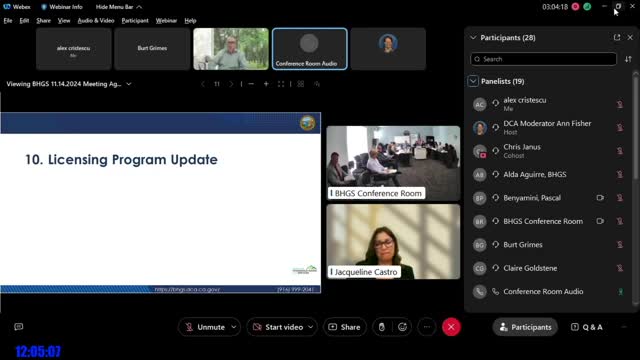Lab reveals alarming drop in product compliance rates
November 14, 2024 | Bureau of Household Goods and Services, Other State Agencies, Executive, California
This article was created by AI summarizing key points discussed. AI makes mistakes, so for full details and context, please refer to the video of the full meeting. Please report any errors so we can fix them. Report an error »

The Bureau of Household Goods and Services held an Advisory Council meeting on November 14, 2024, focusing on updates regarding licensing, laboratory operations, and compliance statistics. The meeting began with a discussion on the current state of licensing, where it was noted that there has been no change in the testing process, despite a significant drop in pass rates, which have fallen to the eighties for the first time since the program's inception.
Jacob Aker, the laboratory manager, provided an update on laboratory activities, highlighting a shift in focus towards thermal insulation testing, which has resulted in a decrease in mattress and flame retardant chemical testing. He reported that the lab successfully renewed its National Voluntary Laboratory Accreditation Program (NAPLOP) accreditation without any findings, indicating strong compliance with updated procedures.
Aker also discussed upcoming deadlines for thermal insulation manufacturers, emphasizing the importance of compliance to avoid removal from the directory. He announced an upcoming conference in San Diego, scheduled for April 30 to May 1, 2025, which will feature updates from the Product Safety Commission.
The council addressed concerns regarding the lengthy testing process for furniture and mattresses, which currently takes between three to six months. Aker expressed hopes to reduce this timeframe as the lab continues to improve its operations. The discussion also touched on the potential for statewide product recalls for serious violations, similar to federal recall processes.
Statistical updates revealed a 99% pass rate for California's smolder resistance test for upholstery furniture, while mattress testing showed a concerning 39% failure rate. The lab is shifting to more targeted sampling methods to address compliance issues, particularly in light of new legislation banning fiberglass in mattresses.
The meeting concluded with a review of labeling compliance, revealing that only 22% of labels passed inspection without issues, while 55% were found to be out of compliance. The council emphasized the need for ongoing improvements in labeling practices to protect consumers and ensure industry compliance.
Overall, the meeting underscored the bureau's commitment to enhancing safety standards and compliance within the household goods and services sector, with a focus on improving testing efficiency and addressing emerging trends in product safety.
Jacob Aker, the laboratory manager, provided an update on laboratory activities, highlighting a shift in focus towards thermal insulation testing, which has resulted in a decrease in mattress and flame retardant chemical testing. He reported that the lab successfully renewed its National Voluntary Laboratory Accreditation Program (NAPLOP) accreditation without any findings, indicating strong compliance with updated procedures.
Aker also discussed upcoming deadlines for thermal insulation manufacturers, emphasizing the importance of compliance to avoid removal from the directory. He announced an upcoming conference in San Diego, scheduled for April 30 to May 1, 2025, which will feature updates from the Product Safety Commission.
The council addressed concerns regarding the lengthy testing process for furniture and mattresses, which currently takes between three to six months. Aker expressed hopes to reduce this timeframe as the lab continues to improve its operations. The discussion also touched on the potential for statewide product recalls for serious violations, similar to federal recall processes.
Statistical updates revealed a 99% pass rate for California's smolder resistance test for upholstery furniture, while mattress testing showed a concerning 39% failure rate. The lab is shifting to more targeted sampling methods to address compliance issues, particularly in light of new legislation banning fiberglass in mattresses.
The meeting concluded with a review of labeling compliance, revealing that only 22% of labels passed inspection without issues, while 55% were found to be out of compliance. The council emphasized the need for ongoing improvements in labeling practices to protect consumers and ensure industry compliance.
Overall, the meeting underscored the bureau's commitment to enhancing safety standards and compliance within the household goods and services sector, with a focus on improving testing efficiency and addressing emerging trends in product safety.
View full meeting
This article is based on a recent meeting—watch the full video and explore the complete transcript for deeper insights into the discussion.
View full meeting
